History of photography
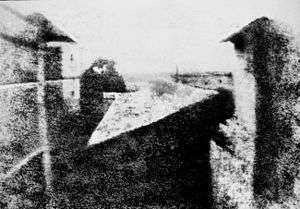
The history of photography has roots in remote antiquity with the discovery of the principle of the camera obscura (a dark room) and the observation that some substances are visibly altered by exposure to light. As far as is known, nobody thought of bringing these two phenomena together to capture camera images in permanent form until around 1800, when Thomas Wedgwood made the first reliably documented although unsuccessful attempt. In the mid-1820s, Nicéphore Niépce succeeded, but several days of exposure in the camera were required and the earliest results were very crude. Niépce's associate Louis Daguerre went on to develop the daguerreotype process, the first publicly announced photographic process, which required only minutes of exposure in the camera and produced clear, finely detailed results. It was commercially introduced in 1839, a date generally accepted as the birth year of practical photography.[1][2]
The metal-based daguerreotype process soon had some competition from the paper-based calotype negative and salt print processes invented by William Henry Fox Talbot. Subsequent innovations reduced the required camera exposure time from minutes to seconds and eventually to a small fraction of a second; introduced new photographic media which were more economical, sensitive or convenient, including roll films for casual use by amateurs; and made it possible to take pictures in natural color as well as in black-and-white.
The commercial introduction of computer-based electronic digital cameras in the 1990s soon revolutionized photography. During the first decade of the 21st century, traditional film-based photochemical methods were increasingly marginalized as the practical advantages of the new technology became widely appreciated and the image quality of moderately priced digital cameras was continually improved.
Etymology
The coining of the word "photography" is usually attributed to Sir John Herschel in 1839. It is based on the Greek φῶς (phos), (genitive: phōtós) meaning "light", and γραφή (graphê), meaning "drawing, writing", together meaning "drawing with light".[3]
Technological background

Photography is the result of combining several different technical discoveries. Long before the first photographs were made, Greek mathematicians Aristotle and Euclid described a pinhole camera in the 5th and 4th centuries BCE.[4][5] In the 6th century CE, Byzantine mathematician Anthemius of Tralles used a type of camera obscura in his experiments[6]
Ibn al-Haytham (Alhazen) (965 in Basra – c. 1040 in Cairo) studied the camera obscura and pinhole camera,[5][7] Albertus Magnus (1193/1206–80) discovered silver nitrate, and Georges Fabricius (1516–71) discovered silver chloride. Daniel Barbaro described a diaphragm in 1568. Wilhelm Homberg described how light darkened some chemicals (photochemical effect) in 1694. The novel Giphantie (by the French Tiphaigne de la Roche, 1729–74) described what could be interpreted as photography.
Development of chemical photography
Monochrome process

In 1614, Angelo Sala demonstrated that "powdered silver nitrate is blackened by the sun",[9] as was paper that was wrapped around it. This discovery of the sun's effect on powdered silver nitrate was not supported and was subsequently disregarded by then-respected scientists who said that his discovery "had no practical application."
Around 1717,[n 1] Johann Heinrich Schulze, a German professor of anatomy and physics, set down a bottle containing silver nitrate and chalk by the window. unintentionally in the path of incoming light from the sun. The mixture, unsurprisingly, turned dark but what he found to be strange was that part was still white and formed a line across the bottle. Schulze observed a cord hanging down and going across in front of the window, which, he found out, was the cause. On further examination, he found that the entire mixture inevitably reverted to its original white color. Experimenting further, Schulze succeeded in transferring words he pasted on the bottle printed into the substance.[10]
Describing his achievement, Schulze wrote that “[t]he sun’s rays, where they hit the glass through the cut-out parts of the paper, wrote each word or sentence on the chalk precipitate so exactly and distinctly that many who were curious about the experiment but ignorant of its nature took occasion to attribute the thing to some sort of trick.”[11] He put the silver nitrate in an oven, which had no effect on its color. This proved to him, definitively, that heat had not facilitated the transformation, as popularly suspected. Rather, it was the light.[11]
In 1777, the chemist Carl Wilhelm Scheele was studying the more intrinsically light-sensitive silver chloride and determined that light darkened it by disintegrating it into microscopic dark particles of metallic silver. Of greater potential usefulness, Scheele found that ammonia dissolved the silver chloride but not the dark particles. This discovery, which could have been used to stabilize or "fix" a camera image captured with silver chloride, was little-noticed at the time and unknown to the earliest photography experimenters.
It was not until around the year 1800 that Thomas Wedgwood made the first known attempt to capture the image in a camera obscura by means of a light-sensitive substance. He used paper or white leather treated with silver nitrate. Although he succeeded in capturing the shadows of objects placed on the surface in direct sunlight, and even made shadow-copies of paintings on glass, it was reported in 1802 that "[t]he images formed by means of a camera obscura have been found too faint to produce, in any moderate time, an effect upon the nitrate of silver." The shadow images eventually darkened all over because "[n]o attempts that have been made to prevent the uncoloured part of the copy or profile from being acted upon by light have as yet been successful."[12] Wedgwood may have prematurely abandoned his experiments due to frail and failing health; he died aged 34 in 1805.
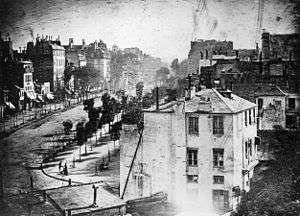
In 1816 Nicéphore Niépce, using paper coated with silver chloride, succeeded in photographing the images formed in a small camera, but the photographs were negatives, darkest where the camera image was lightest and vice versa, and they were not permanent in the sense of being reasonably light-fast; like earlier experimenters, Niépce could find no way to prevent the coating from darkening all over when it was exposed to light for viewing. Disenchanted with silver salts, he turned his attention to light-sensitive organic substances.[13]



The oldest surviving photograph of the image formed in a camera was created by Niépce in 1826 or 1827.[1] It was made on a polished sheet of pewter and the light-sensitive substance was a thin coating of bitumen, a naturally occurring petroleum tar, which was dissolved in lavender oil, applied to the surface of the pewter and allowed to dry before use.[15] After a very long exposure in the camera (traditionally said to be eight hours, but now believed to be several days),[16] the bitumen was sufficiently hardened in proportion to its exposure to light that the unhardened part could be removed with a solvent, leaving a positive image with the light areas represented by hardened bitumen and the dark areas by bare pewter.[15] To see the image plainly, the plate had to be lit and viewed in such a way that the bare metal appeared dark and the bitumen relatively light.[13]
In partnership, Niépce in Chalon-sur-Saône and Louis Daguerre in Paris refined the bitumen process,[17] substituting a more sensitive resin and a very different post-exposure treatment that yielded higher-quality and more easily viewed images. Exposure times in the camera, although substantially reduced, were still measured in hours.[13]
Niépce died suddenly in 1833, leaving his notes to Daguerre. More interested in silver-based processes than Niépce had been, Daguerre experimented with photographing camera images directly onto a mirror-like silver-surfaced plate that had been fumed with iodine vapor, which reacted with the silver to form a coating of silver iodide. As with the bitumen process, the result appeared as a positive when it was suitably lit and viewed. Exposure times were still impractically long until Daguerre made the pivotal discovery that an invisibly slight or "latent" image produced on such a plate by a much shorter exposure could be "developed" to full visibility by mercury fumes. This brought the required exposure time down to a few minutes under optimum conditions. A strong hot solution of common salt served to stabilize or fix the image by removing the remaining silver iodide. On 7 January 1839, this first complete practical photographic process was announced at a meeting of the French Academy of Sciences,[18] and the news quickly spread. At first, all details of the process were withheld and specimens were shown only at Daguerre's studio, under his close supervision, to Academy members and other distinguished guests.[19] Arrangements were made for the French government to buy the rights in exchange for pensions for Niépce's son and Daguerre and present the invention to the world (with the exception of Great Britain, where an agent for Daguerre patented it) as a free gift.[20] Complete instructions were made public on 19 August 1839.[21]
After reading early reports of Daguerre's invention, Henry Fox Talbot, who had succeeded in creating stabilized photographic negatives on paper in 1835, worked on perfecting his own process. In early 1839, he acquired a key improvement, an effective fixer, from his friend John Herschel, a polymath scientist who had previously shown that hyposulfite of soda (commonly called "hypo" and now known formally as sodium thiosulfate) would dissolve silver salts.[22] News of this solvent also benefited Daguerre, who soon adopted it as a more efficient alternative to his original hot salt water method.[23]

Talbot's early silver chloride "sensitive paper" experiments required camera exposures of an hour or more. In 1840, Talbot invented the calotype process, which, like Daguerre's process, used the principle of chemical development of a faint or invisible "latent" image to reduce the exposure time to a few minutes. Paper with a coating of silver iodide was exposed in the camera and developed into a translucent negative image. Unlike a daguerreotype, which could only be copied by rephotographing it with a camera, a calotype negative could be used to make a large number of positive prints by simple contact printing. The calotype had yet another distinction compared to other early photographic processes, in that the finished product lacked fine clarity due to its translucent paper negative. This was seen as a positive attribute for portraits because it softened the appearance of the human face. Talbot patented this process,[24] which greatly limited its adoption, and spent many years pressing lawsuits against alleged infringers. He attempted to enforce a very broad interpretation of his patent, earning himself the ill will of photographers who were using the related glass-based processes later introduced by other inventors, but he was eventually defeated. Nonetheless, Talbot's developed-out silver halide negative process is the basic technology used by chemical film cameras today. Hippolyte Bayard had also developed a method of photography but delayed announcing it, and so was not recognized as its inventor.
In 1839, John Herschel made the first glass negative, but his process was difficult to reproduce. Slovene Janez Puhar invented a process for making photographs on glass in 1841; it was recognized on June 17, 1852 in Paris by the Académie Nationale Agricole, Manufacturière et Commerciale.[25] In 1847, Nicephore Niépce's cousin, the chemist Niépce St. Victor, published his invention of a process for making glass plates with an albumen emulsion; the Langenheim brothers of Philadelphia and John Whipple and William Breed Jones of Boston also invented workable negative-on-glass processes in the mid-1840s.[26]
In 1851 Frederick Scott Archer invented the collodion process.[27] Photographer and children's author Lewis Carroll used this process. (Carroll refers to the process as "Tablotype" [sic] in the story "A Photographer's Day Out")[28]

Herbert Bowyer Berkeley experimented with his own version of collodion emulsions after Samman introduced the idea of adding dithionite to the pyrogallol developer. Berkeley discovered that with his own addition of sulfite, to absorb the sulfur dioxide given off by the chemical dithionite in the developer, that dithionite was not required in the developing process. In 1881 he published his discovery. Berkeley's formula contained pyrogallol, sulfite and citric acid. Ammonia was added just before use to make the formula alkaline. The new formula was sold by the Platinotype Company in London as Sulpho-Pyrogallol Developer.[29]
Nineteenth-century experimentation with photographic processes frequently became proprietary. The German-born, New Orleans photographer Theodore Lilienthal successfully sought legal redress in an 1881 infringement case involving his "Lambert Process" in the Eastern District of Louisiana.
Popularization


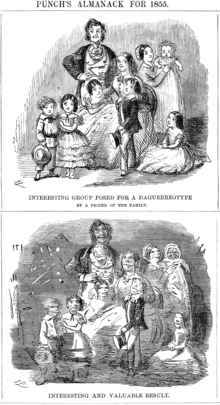
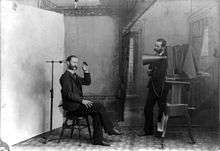

The daguerreotype proved popular in response to the demand for portraiture that emerged from the middle classes during the Industrial Revolution. This demand, which could not be met in volume and in cost by oil painting, added to the push for the development of photography.
Roger Fenton and Philip Henry Delamotte helped popularize the new way of recording events, the first by his Crimean war pictures, the second by his record of the disassembly and reconstruction of The Crystal Palace in London. Other mid-nineteenth-century photographers established the medium as a more precise means than engraving or lithography of making a record of landscapes and architecture: for example, Robert Macpherson's broad range of photographs of Rome, the interior of the Vatican, and the surrounding countryside became a sophisticated tourist's visual record of his own travels.
In America, by 1851 a broadside by daguerreotypist Augustus Washington was advertising prices ranging from 50 cents to $10.[30] However, daguerreotypes were fragile and difficult to copy. Photographers encouraged chemists to refine the process of making many copies cheaply, which eventually led them back to Talbot's process.
Ultimately, the photographic process came about from a series of refinements and improvements in the first 20 years. In 1884 George Eastman, of Rochester, New York, developed dry gel on paper, or film, to replace the photographic plate so that a photographer no longer needed to carry boxes of plates and toxic chemicals around. In July 1888 Eastman's Kodak camera went on the market with the slogan "You press the button, we do the rest". Now anyone could take a photograph and leave the complex parts of the process to others, and photography became available for the mass-market in 1901 with the introduction of the Kodak Brownie.
Color process

A practical means of color photography was sought from the very beginning. Results were demonstrated by Edmond Becquerel as early as 1848, but exposures lasting for hours or days were required and the captured colors were so light-sensitive they would only bear very brief inspection in dim light.
The first durable color photograph was a set of three black-and-white photographs taken through red, green and blue color filters and shown superimposed by using three projectors with similar filters. It was taken by Thomas Sutton in 1861 for use in a lecture by the Scottish physicist James Clerk Maxwell, who had proposed the method in 1855.[31] The photographic emulsions then in use were insensitive to most of the spectrum, so the result was very imperfect and the demonstration was soon forgotten. Maxwell's method is now most widely known through the early 20th century work of Sergei Prokudin-Gorskii. It was made practical by Hermann Wilhelm Vogel's 1873 discovery of a way to make emulsions sensitive to the rest of the spectrum, gradually introduced into commercial use beginning in the mid-1880s.
Two French inventors, Louis Ducos du Hauron and Charles Cros, working unknown to each other during the 1860s, famously unveiled their nearly identical ideas on the same day in 1869. Included were methods for viewing a set of three color-filtered black-and-white photographs in color without having to project them, and for using them to make full-color prints on paper.[32]
The first widely used method of color photography was the Autochrome plate, a process inventors and brothers Auguste and Louis Lumière began working on in the 1890's and commercially introduced in 1907.[33] It was based on one of Louis Ducos du Hauron's ideas: instead of taking three separate photographs through color filters, take one through a mosaic of tiny color filters overlaid on the emulsion and view the results through an identical mosaic. If the individual filter elements were small enough, the three primary colors of red, blue, and green would blend together in the eye and produce the same additive color synthesis as the filtered projection of three separate photographs.

Autochrome plates had an integral mosaic filter layer with roughly five million previously dyed potato grains per square inch added to the surface. Then through the use of a rolling press, five tons of pressure were used to flatten the grains, enabling every one of them to capture and absorb color and their microscopic size allowing the illusion that the colors are merged together. The final step was adding a coat of the light capturing substance silver bromide after which a color image could be imprinted and developed. In order to see it, reversal processing was used to develop each plate into a transparent positive that could be viewed directly or projected with an ordinary projector. One of the drawbacks of the technology is an exposure time of at least a second was required during the day in bright light and the worse the light is, the time required quickly goes up. An indoor portrait required a few minutes with the subject not being able to move or else the picture would come out blurry. The reason for this is due to the fact that the grains absorb the color fairly slow, and that a filter of a yellowish-orange color was added to the plate to keep the photograph from coming out excessively blue. Although necessary, the filter had the effect of reducing the amount of light that was absorbed. Another drawback was that the film could only be enlarged so much until the many dots that make up the image become apparent.[33][34]
Competing screen plate products soon appeared and film-based versions were eventually made. All were expensive and until the 1930s none was "fast" enough for hand-held snapshot-taking, so they mostly served a niche market of affluent advanced amateurs.
A new era in color photography began with the introduction of Kodachrome film, available for 16 mm home movies in 1935 and 35 mm slides in 1936. It captured the red, green and blue color components in three layers of emulsion. A complex processing operation produced complementary cyan, magenta and yellow dye images in those layers, resulting in a subtractive color image. Maxwell's method of taking three separate filtered black-and-white photographs continued to serve special purposes into the 1950s and beyond, and Polachrome, an "instant" slide film that used the Autochrome's additive principle, was available until 2003, but the few color print and slide films still being made in 2015 all use the multilayer emulsion approach pioneered by Kodachrome.
Development of digital photography
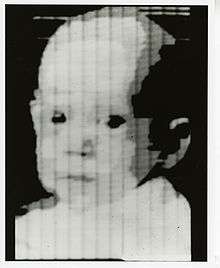
In 1957, a team led by Russell A. Kirsch at the National Institute of Standards and Technology developed a binary digital version of an existing technology, the wirephoto drum scanner, so that alphanumeric characters, diagrams, photographs and other graphics could be transferred into digital computer memory. One of the first photographs scanned was a picture of Kirsch's infant son Walden. The resolution was 176x176 pixels with only one bit per pixel, i.e., stark black and white with no intermediate gray tones, but by combining multiple scans of the photograph done with different black-white threshold settings, grayscale information could also be acquired.[35]
The charge-coupled device (CCD) is the image-capturing optoelectronic component in first-generation digital cameras. It was invented in 1969 by Willard Boyle and George E. Smith at AT&T Bell Labs as a memory device. The lab was working on the Picturephone and on the development of semiconductor bubble memory. Merging these two initiatives, Boyle and Smith conceived of the design of what they termed "Charge 'Bubble' Devices". The essence of the design was the ability to transfer charge along the surface of a semiconductor. It was Dr. Michael Tompsett from Bell Labs however, who discovered that the CCD could be used as an imaging sensor. The CCD has increasingly been replaced by the active pixel sensor (APS), commonly used in cell phone cameras.
- 1973 – Fairchild Semiconductor releases the first large image-capturing CCD chip: 100 rows and 100 columns.[36]
- 1975 – Bryce Bayer of Kodak develops the Bayer filter mosaic pattern for CCD color image sensors
- 1986 – Kodak scientists develop the world's first megapixel sensor.
The web has been a popular medium for storing and sharing photos ever since the first photograph was published on the web by Tim Berners-Lee in 1992 (an image of the CERN house band Les Horribles Cernettes). Today popular sites such as Flickr, Picasa, Instagram and PhotoBucket are used by millions of people to share their pictures.
See also
- History of the camera
- History of Photography (academic journal)
- History of photographic lens design
- Timeline of photography technology
- List of basic photography topics
- Photography by indigenous peoples of the Americas
- Women in photography
- Movie camera
Notes
- ↑ This date is commonly misreported as 1725 or 1727, an error deriving from the belief that a 1727 publication of Schulze's account of experiments he says he undertook about two years earlier is the original source. In fact, it is a reprint of a 1719 publication and the date of the experiments is therefore circa 1717. The dated contents page of the true original can be seen here (retrieved 21 February 2015)
References
- 1 2 Seizing the Light: A History of Photography By Robert Hirsch
- ↑ The Michigan Technic 1882 The Genesis of Photography with Hints on Developing
- ↑ Online Etymology Dictionary
- ↑ "Light Through the Ages".
- 1 2 Robert E. Krebs (2004). Groundbreaking Scientific Experiments, Inventions, and Discoveries of the Middle Ages and the Renaissance. Greenwood Publishing Group. ISBN 0-313-32433-6.
- ↑ Alistair Cameron Crombie, Science, optics, and music in medieval and early modern thought, p. 205
- ↑ Wade, Kaitlyjj; Finger, Stanley (2001). "The eye as an optical instrument: from camera obscura to Helmholtz's perspective". Perception. 30 (10): 1157–77. doi:10.1068/p3210. PMID 11721819.
- ↑ "The First Photograph — Heliography". Retrieved 29 September 2009.
from Helmut Gernsheim's article, "The 150th Anniversary of Photography," in History of Photography, Vol. I, No. 1, January 1977: ...In 1822, Niépce coated a glass plate... The sunlight passing through... This first permanent example... was destroyed... some years later.
- ↑ Friedman, Avner; Ross, David (2012). Mathematical Models in Photographic Science. Springer Science & Business Media. p. 4. ISBN 9783642557552.
- ↑ Thomas Peter Garrett (1917). "The Wonderful Development of Photography". The Art World. The Frick Collection.
- 1 2 Jane E. Boyd. "Silver and Sunlight: The Science of Early Photography". Chemical Heritage Foundation.
- ↑ Litchfield, R. 1903. "Tom Wedgwood, the First Photographer: An Account of His Life." London, Duckworth and Co. See Chapter XIII. Includes the complete text of Humphry Davy's 1802 paper, which is the only known contemporary record of Wedgwood's experiments. (Retrieved 7 May 2013 via archive.org).
- 1 2 3 Niépce Museum history pages
- ↑ Folpe, Emily Kies (2002). It Happened on Washington Square. Baltimore: Johns Hopkins University Press. p. 94. ISBN 0-8018-7088-7.
- 1 2 By Christine Sutton
- ↑ Niépce House Museum: Invention of Photography, Part 3. Retrieved 25 May 2013. The traditional estimate of eight or nine hours originated in the 1950s and is based mainly on the fact that sunlight strikes the buildings as if from an arc across the sky, an effect which several days of continuous exposure would also produce.
- ↑ "Daguerre (1787–1851) and the Invention of Photography". Timeline of Art History. Metropolitan Museum of Art. October 2004. Retrieved 2008-05-06.
- ↑ (Arago, François) (1839) "Fixation des images qui se forment au foyer d'une chambre obscure" (Fixing of images formed at the focus of a camera obscura), Comptes rendus, 8 : 4-7.
- ↑ e.g., a 9 May 1839 showing to John Herschel, documented by Herschel's letter to WHF Talbot. See the included footnote #1 (by Larry Schaaf?) for context. Accessed 11 September 2014.
- ↑ Daguerre (1839), pages 1-4.
- ↑ See:
- (Arago, François) (1839) "Le Daguerreotype", Comptes rendus, 9 : 250-267.
- Daguerre, Historique et description des procédés du Daguerréotype et du diorama [History and description of the processes of the daguerreotype and diorama] (Paris, France: Alphonse Giroux et Cie., 1839).
- ↑ John F. W. Herschel (1839) "Note on the art of photography, or the application of the chemical rays of light to the purposes of pictorial representation," Proceedings of the Royal Society of London, 4 : 131-133. On page 132 Herschel mentions the use of hyposulfites.
- ↑ Daguerre, Historique et description des procédés du Daguerréotype et du diorama [History and description of the processes of the daguerreotype and diorama] (Paris, France: Alphonse Giroux et Cie., 1839). On page 11, for example, Daguerre states: "Cette surabondance contribue à donner des tons roux, même en enlevant entièrement l'iode au moyen d'un lavage à l'hyposulfite de soude ou au sel marin." (This overabundance contributes towards giving red tones, even while completely removing the iodine by means of a rinse in sodium hyposulfite or in sea salt.)
- ↑ Improvement in photographic pictures, Henry Fox Talbot, United States Patent Office, patent no. 5171, June 26, 1847.
- ↑ "Life and work of Janez Puhar | (accessed December 13, 2009)".
- ↑ Michael R. Peres (2007). The Focal encyclopedia of photography: digital imaging, theory and applications, history, and science. Focal Press. p. 38. ISBN 978-0-240-80740-9.
- ↑ Richard G. Condon (1989). "The History and Development of Arctic Photography". Arctic Anthropology. 26: 52. JSTOR 40316177.
- ↑ The Complete Works of Lewis Carroll, from the Random House Modern Library
- ↑ Levenson, G. I. P (May 1993). "Berkeley, overlooked man of photo science". Photographic Journal. 133 (4): 169–71.
- ↑ Loke, Margarett (July 7, 2000). "Photography review; In a John Brown Portrait, The Essence of a Militant". The New York Times. Retrieved 2007-03-16.
- ↑ James Clerk Maxwell (2003). The Scientific Papers of James Clerk Maxwell. Courier Dover Publications. p. 449. ISBN 0-486-49560-4.
- ↑ Brian, Coe (1976). The Birth of Photography. Ash & Grant. ISBN 0-904069-07-9.
- 1 2 Douglas R. Nickel (1992). "Autochromes by Clarence H. White". Record of the Art Museum, Princeton University. 2. 51: 31–32.
- ↑ "Potatoes to Pictures". The American Museum of Photography. The American Photography Museum.
- ↑ SEAC and the Start of Image Processing at the National Bureau of Standards – Earliest Image Processing
- ↑ Janesick, James R (2001). Scientific Charge Coupled Devices. SPIE Press. ISBN 0-8194-3698-4.
Further reading
- Hannavy, John. Encyclopedia of Nineteenth-Century Photography, 5 volumes
- Clerc, L.P. Photography Theory and Practice, being an English edition of "La Technique Photographique"
External links
| Wikimedia Commons has media related to History of photography. |
- The Silver Canvas: Daguerreotype Masterpieces from the J. Paul Getty Museum Bates Lowry, Isabel Barrett Lowry 1998
- A History of Photography from its Beginnings Till the 1920s by Dr. Robert Leggat, now hosted by Dr Michael Prichard
- The First Photograph at The University of Texas at Austin
- Photo Histories, the photographers' history of photography
- The Photo History Timeline Collection
- Niepce Museum
- Video (09:03) – notable historical still images – now colorized.
- cww2.colorado